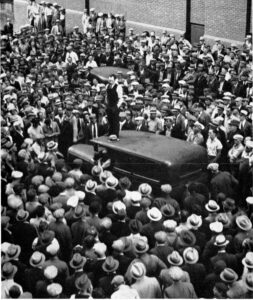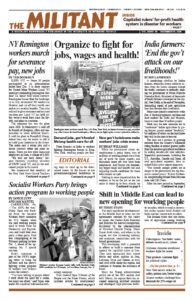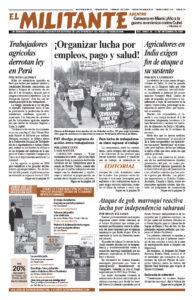
The Struggle for Socialism in the “American Century”: Writings and Speeches, 1945-47 by James P. Cannon is one of Pathfinder’s Books of the Month for December. In the face of the U.S. rulers’ swaggering claim to global domination following their victory in the second imperialist world war, Cannon, then national secretary of the Socialist Workers Party, lays out the prospects for working-class revolutionary struggle with total confidence in its victory. The excerpt is from the SWP’s 1946 basic programmatic document, “Theses on the American Revolution.” Copyright © 1977 by Pathfinder Press. Reprinted by permission.
BY JAMES P. CANNON
The United States, the most powerful capitalist country in history, is a component part of the world capitalist system and is subject to the same general laws. It suffers from the same incurable diseases and is destined to share the same fate. The overwhelming preponderance of American imperialism does not exempt it from the decay of world capitalism, but on the contrary acts to involve it ever more deeply, inextricably, and hopelessly. U.S. capitalism can no more escape from the revolutionary consequences of world capitalist decay than the older European capitalist powers. The blind alley in which world capitalism has arrived, and the U.S. with it, excludes a new organic era of capitalist stabilization. The dominant world position of American imperialism now accentuates and aggravates the death agony of capitalism as a whole.
American imperialism emerged victorious from the Second World War, not merely over its German and Japanese rivals, but also over its “democratic” allies, especially Great Britain. Today Wall Street unquestionably is the dominant world imperialist center. Precisely because it has issued from the war vastly strengthened in relation to all its capitalist rivals, U.S. imperialism seems indomitable. So overpowering in all fields — diplomatic, military, commercial, financial, and industrial — is Wall Street’s preponderance that consolidation of its world hegemony seems to be within easy reach. Wall Street hopes to inaugurate the so-called American Century.
In reality, the American ruling class faces more insurmountable obstacles in “organizing the world” than confronted the German bourgeoisie in its repeated and abortive attempts to attain a much more modest goal, namely: “organizing Europe.”
The meteoric rise of U.S. imperialism to world supremacy comes too late. Moreover, American imperialism rests increasingly on the foundations of world economy, in sharp contrast to the situation prevailing before the First World War, when it rested primarily on the internal market — the source of its previous successes and equilibrium. But the world foundation is today shot through with insoluble contradictions; it suffers from chronic dislocations and is mined with revolutionary powder kegs. …
The economic prerequisites for the socialist revolution are fully matured in the U.S. The political premises are likewise far more advanced than might appear on the surface. …
The issue of socialism or capitalism will not be finally decided until it is decided in the U.S. Another retardation of the proletarian revolution in one country or another, or even one continent or another, will not save American imperialism from its proletarian nemesis at home. The decisive battles for the communist future of mankind will be fought in the U.S. …
Much has been said about the “backwardness” of the American working class as a justification for a pessimistic outlook, the postponement of the socialist revolution to a remote future, and withdrawal from the struggle. This is a very superficial view of the American workers and their prospects.
It is true that this class, in many respects the most advanced and progressive in the world, has not yet taken the road of independent political action on a mass scale. But this weakness can be swiftly overcome. Under the compulsion of objective necessity not only backward peoples but backward classes in advanced countries find themselves driven to clear great distances in single leaps. As a matter of fact, the American working class has already made one such leap which has advanced it far ahead of its old positions.
The workers entered the 1929 crisis as an unorganized, atomized mass imbued with illusions concerning “rugged individualism,” “private initiative,” “free enterprise,” “the American Way,” etc., etc. Less than 10 percent of the class as a whole was organized on the trade union field (fewer than 3 million out of 33 million in 1929). Moreover, this thin layer embraced primarily the highly skilled and privileged workers, organized in antiquated craft unions. The main and most decisive section of the workers knew unionism only as “company unionism,” remaining without the benefit, the experience, and even the understanding of the most elementary form of workers’ organization — the trade union. They were regarded and treated as mere raw material for capitalist exploitation, without rights or protection or any security of employment.
As a consequence, the 1929 crisis found the working class helpless and impotent. For three years the masses remained stunned and disoriented by the disaster. Their resistance was extremely limited and sporadic. But their anger and resentment accumulated. The next five years (1933-37), coincident with a partial revival of industry, witnessed a series of gigantic clashes, street fights, and sit-down strikes — an embryonic civil war — the end result of which was a leap, a giant leap, for millions of workers from nonexistence as an organized force to trade union consciousness and organization. Once fairly started, the movement for unionism snowballed, embracing today almost 15 million in all the basic industries.
In one leap — in a brief decade — the American workers attained trade union consciousness on a higher plane and with mightier organizations than in any other advanced country. … Under the impact of great events and pressing necessities the American workers will advance beyond the limits of trade unionism and acquire political class consciousness and organization in a similar sweeping movement.

